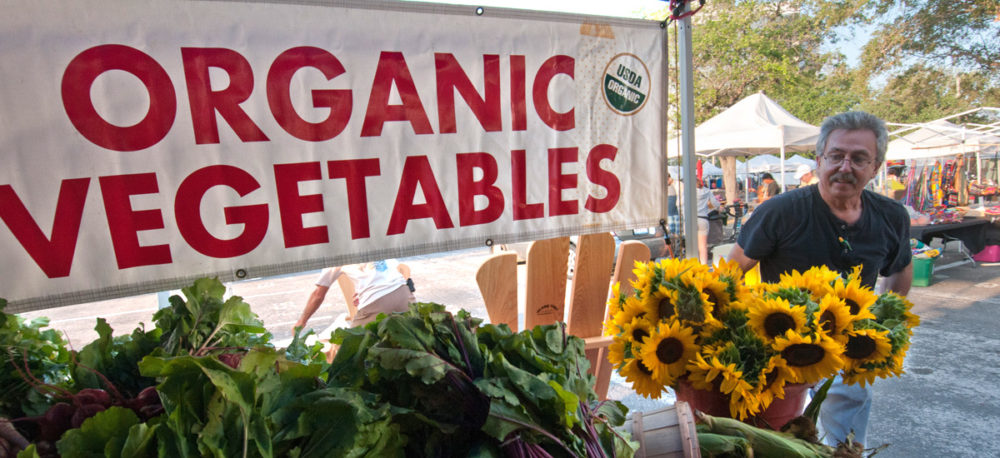The U.S. Department of Agriculture recently released the results of its latest survey of organic farmers, and there’s good news. Organic farming is up nationally, with 12,818 farms generating $6.2 billion in certified organic product sales in 2015, up 13 percent from 2014. But the survey shows that all states aren’t pursuing organic farming equally. And one of the top organic states may surprise you.
USDA started surveying organic farmers in 2008, and periodically reports survey data nationally and state-by-state. Last week’s 2015 Certified Organic Survey reveals the leaders:
- Predictably, California is #1 in organic farms (2,637), acres (790,413), and product sales ($2.4 billion, accounting for 40 percent of the national total).
- Perhaps more surprisingly, Wisconsin is #2. More on that in a minute.
- Other leading states are concentrated in the Eastern U.S. (New York, Pennsylvania, Vermont, and Maine) and on the West coast (Washington and Oregon).
And the laggards:
- The Deep South has many fewer organic farms, with fewer than 30 each in South Carolina and Alabama, just a dozen in Mississippi, and only seven in all of Louisiana.
- And while Virginia has 139 organic farms (23,453 acres, $46 million), more than one-third of those—51 farms—are growing tobacco. (Yes, apparently organic tobacco is a thing, and Virginia leads the nation, with nearly $18.7 million in production.)
And what about organic farming in the Midwest, the nation’s biggest agricultural region? Well, it’s complicated.

Map showing the top 10 US states for organic sales. Graphic: USDA National Agricultural Statistics Service, 2015 Certified Organic Survey.
The state of Midwest organic: Hawkeyes vs. Badgers
Since this is college football season, let’s look at a Big 10 rivalry—Iowa versus Wisconsin—but in terms of organic farming. Iowa is ranked #5 among the states in terms of its number of certified organic farms, with 674 operating in 2015. The state had 93,707 total certified organic acres, and the sales value of the state’s certified organic products was $120.5 million. Sounds good, right?
Sure. But by comparison and as noted above, rival Wisconsin is #2 in the nation, with nearly twice as many certified organic farms (1,205) as Iowa, nearly double Iowa’s organic production value ($222.4 million), and more than double the certified organic acres (209,615).
So why does the Hawkeye State lag so far behind its neighbor?
As the Milwaukee Journal Sentinel notes, Wisconsin has a proudly stubborn tradition of small family farms, a diversity of farm production, and a history of dairy cooperatives (including the now-national Organic Valley, still based in La Farge, WI).
Contrasted with the famed flatness of Iowa prairie, Wisconsin’s landscape is less well-suited to massive swaths of corn and soybeans. That means it’s better for hillside pastures and small crop farms squeezed between forests. Wisconsin also has more cities, which translates to more urban customers for farmers growing a diverse mix of fruits and vegetables.
The USDA survey reveals that fewer than 20 percent of Iowa’s 674 organic farms are selling food direct to consumers, either through CSA arrangements or at markets like the downtown Des Moines Farmers Market, one of the nation’s best. Yet overall, Iowa’s organic production is a microcosm of the state’s overall agricultural scene, by which I mean it’s overwhelmingly dominated by commodity corn and soybeans.
Why haven’t more Iowa farmers made the shift from growing mostly raw materials for organic tortilla chips to a more diverse and healthful landscape of sustainably-grown foods?
Policy support is key to organic success
I posed that question to someone in Iowa who would know. Kate Mendenhall is Managing Director of the Iowa Organic Association, and is herself a beginning farmer in her second year of transitioning to organic. She and her partner farm 18.5 acres of pasture in Okoboji, in the northwest part of the state, where they hope next year to have pastured poultry and pastured pigs on the land.
After acknowledging the geographic and cultural issues above, Kate also had this to say:
Iowa is plagued by a heavy presence of multi-national agribusiness and a conservative state farm bureau, which do not, unfortunately, favor out of the box thinking for what types of agriculture would be best for Iowa families and Iowa family farmers.
With corn prices as low as they are currently, and many farmers feeling the heavy burden of commodity conventional agriculture at the moment, Iowa farmers, Iowa state government and Iowa State University would benefit by studying their neighbor’s vibrant local organic food system. Wisconsin’s family farmers have benefited by investing in more organic acreage, and now is the time for Iowa to pass policies that encourage Iowa farmers to transition to organic.
In particular, Kate wants the state of Iowa to provide farmers with subsidies to offset the financial risk of the USDA’s three-year organic transition period, when they are using organic methods but aren’t yet certified, and thus can’t command organic prices. She also says the state could better protect its organic farmers by enforcing federal pesticide regulations and more aggressively stopping the pesticide drift from neighboring farms, which may discourage some farmers from seeking organic certification.
Market trends support such recommendations. Demand for local food is high, and demand for organic food now outpaces supply. This extends to institutions as well as individuals, and the heartland as well as the coasts. As a 2015 UCS report found, growing a diverse mix of foods for sale to the state’s restaurants, grocery stores, hospitals, and schools (much of which could be grown organically) would be a boon for Iowa farmers and rural communities.
Iowa policymakers—and their counterparts at the federal level—would do well to help farmers grow more of the foods Americans want today.

